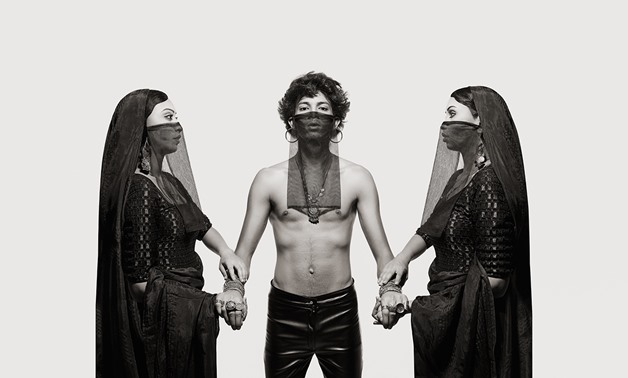
Photography by Habby Khalil
Photography by Habby Khalil
Once upon a real time, there were two sisters named Raya and Sakina, who for years kidnapped and killed women for their money and jewelry. With the help of their husbands and others, the two women would lure victims into their home, drug and kill them before burying their bodies under the tiles. Their killing spree spanned a period of one year, leading to the deaths of 17 women. In 1921, they were sentenced to death, making them the first women to hang for their crimes under Egypt’s modern law.
The crimes have been the subject of numerous films, series and plays, but last month’s photography exhibition at Picasso Gallery was the talk of the town where Habby Khalil reimagined the two sisters in a series of photographs, this time with a male victim who is depicted as lost and afraid. “While many artists have worked on the concept dealing with the crime itself, Khalil—a self-taught visual artist who uses history as his muse—explores the execution process and sister’s different reactions; the ‘silent’ Raya versus the boasted bravery of Sakina, thus exploring the possibility of multiple convictions leading to the same act,” the exhibit’s curators explain.

Photography by Habby Khalil
The images of the two sisters in crime are styled with modern twists, and many felt they express the power of women and the need to survive and find equality in a man’s world. A closer look reveals the balance and symmetry the sisters convey to the viewer, with their victim. Bracelets and anklets are placed on opposite legs and arms, creating a wall that the sisters use to protect each other and survive, giving no thought to the consequences.
A particularly striking image shows one of the sisters holding a mabkhara, mimicking the scales that symbolize justice. In fact, the mabkhara was used to cover up the smell of the rotting bodies lying under the tiles. The bisha is used as a mask that they hide behind in order to protect themselves from their crimes, as it also keeps them united, while portraying the unbreakable sister pact.
Another image symbolizes spirituality and death, as the bloody hands of their victims have left imprints on the tombstones, where the sisters are hiding. Seduction emanates through their gaze, clashing with what was then considered modest dressing.
 Photography by Habby Khalil
Photography by Habby Khalil
Symmetry and alignment are the major themes of this collection, guiding the viewer to see and feel all of the often-contradictory elements in the photograph. As the curators explain, “The artist explores the story in black and white, symbolizing the eternal conflict and interdependence between different beliefs. The space surrounding the characters reflects their spiritual sanctuary and their inner isolation, a monochromatic state of interaction between subjects and their surroundings. The use of clothing creates a symbolic connection to the connected fate of the two sisters, while visual symmetry invites the viewer to focus on the difference between them.
Exploring the concepts of “trust, doubt, belief, the relationship between justification and action, and which one precedes the other,” the curators add, [Khalil] successfully pits traditional ideologies against modern liberalism by “re-identifying the indefinable elements of an old story that has today become a part of modern Egyptian folklore.”
 Photography by Habby Khalil
About Habby Khalil
Photography by Habby Khalil
About Habby Khalil
Born in 1979, Habby Khalil works primarily in photography, film, and video. He utilizes historical and cultural subjects as a visual language to address sociopolitical issues and has won numerous awards for his photography work, including two gold and two silver medals at the Prix de la Photographie Paris in 2016, and third place prize in Moscow International Foto Awards in 2015. His movie Fi Youm (In a Day) received a Special Mention Award at the 37th Cairo International Film Festival in 2015.
Khalil’s ongoing project, Alienation, depicts five of the most famous deities of ancient Egyptian mythology as they were historically described, but within a different temporal and spatial frame. The project explores our beliefs and how we interpret and practice them, as well as the meaning and purpose of our existence.
 Photography by Habby Khalil
Photography by Habby Khalil

 Photography by Habby Khalil
Photography by Habby Khalil
 Photography by Habby Khalil
Photography by Habby Khalil
 Photography by Habby Khalil
Photography by Habby Khalil
Comments
Leave a Comment